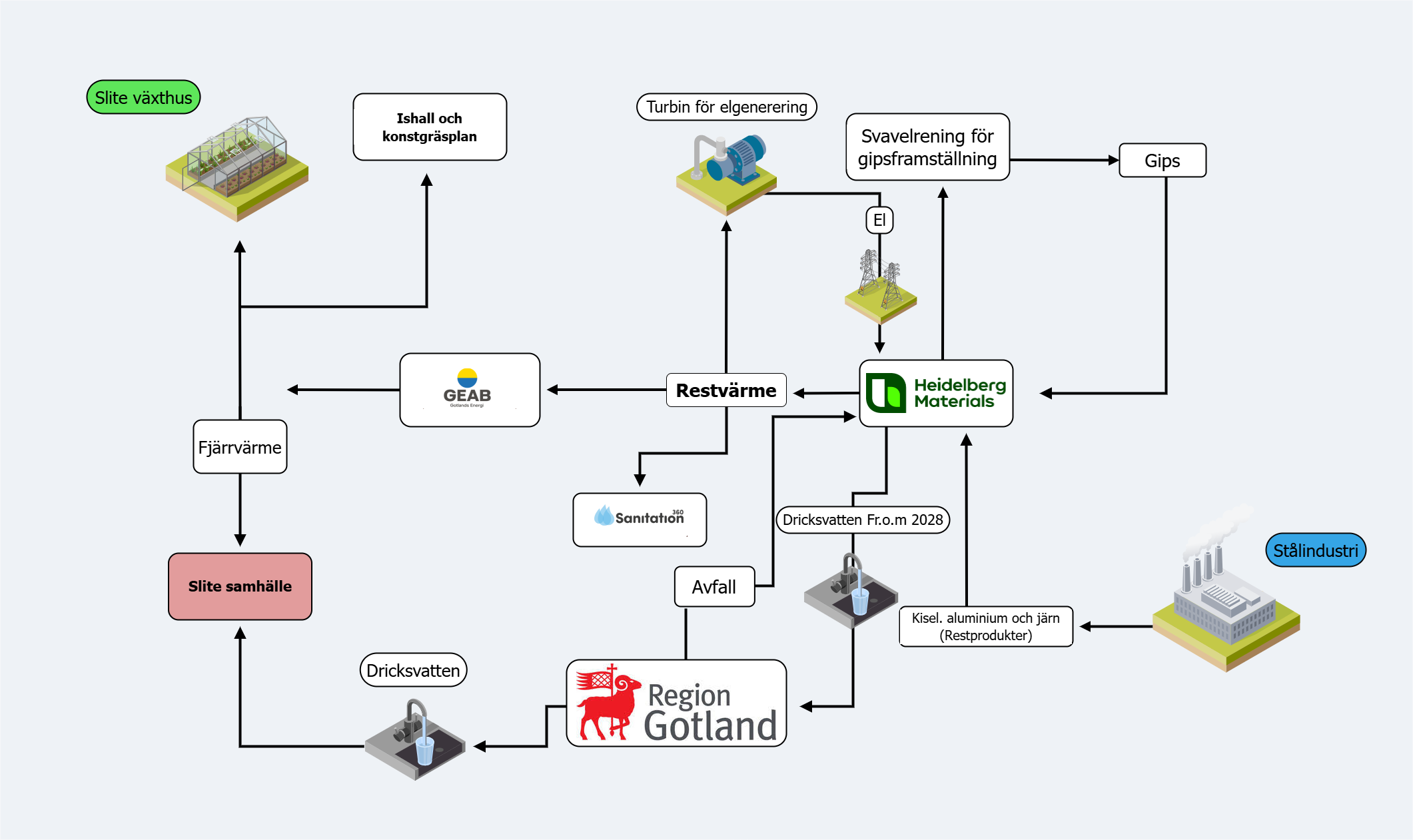Industrial and urban symbiosis in Slite
Cement production and circular economy: A Climate-Smart Transformation.
Advantages
- Biodiversity
- Carbon capture
- Fossil fuels
Overview
In the limestone-rich area of Slite on northern Gotland, cement production has been ongoing since 1919. Today, 7,000 tons of cement are produced daily, accounting for 75% of the cement used in Sweden. Cement production requires high temperatures of 1450 degrees Celsius, which generates excess heat. This excess heat is utilized via Gotlands Energi AB’s district heating network to warm the town of Slite. The heat also goes to Slite’s greenhouses and to Sanitation 360, a start-up producing regenerative fertilizer from urine. A turbine on-site also generates electricity from the excess heat, which powers the factory, and through the municipal energy company, the excess heat is distributed to the town. Heidelberg Materials also supports the local sports association by supplying heat to the ice rink and the artificial grass pitch from the factory.
In addition to limestone, the primary raw material, other materials containing silicon, aluminum, and iron are also required. These were historically sourced from minerals in the earth's crust, but nowadays, they are largely derived from by-products and waste from other industries, such as the steel industry. Cement production also requires significant amounts of fuel for the kiln, and over the years, the cement industry has worked to replace fossil fuels with waste fractions of plastic, textiles, paper, and wood, which contain a high proportion of biofuels. The flue gases from the kiln are cleaned of sulfur dioxide and form gypsum, which is added in the final step of cement grinding. Any material or dust that is separated or spilled is returned to the process, meaning that despite large-scale production, the cement factory in Slite does not generate any material waste from the process.
Highlights
The quarrying required for limestone extraction has a dramatic and partially permanent impact on the biodiversity-rich and unique natural area surrounding Slite. To mitigate these effects, Heidelberg Materials works to achieve a net-zero loss of biodiversity by following a hierarchy of measures to: avoid, minimize, restore, and compensate for damage to the environment. As a result, one of Europe’s largest butterfly surveys was carried out in Slite, where the Nipsippan butterfly, found only in Gotland and Ångermanland, has been inventoried since 2006. Currently, efforts are underway to establish habitats for butterflies and other species typical of Northern Gotland’s natural environments, including in Smöjen, an old limestone quarry located two miles northeast of the Slite factory.
An unavoidable aspect of cement production is the carbon dioxide emitted from limestone. Due to the large-scale production in Slite, the current operation accounts for 4% of Sweden’s total carbon emissions. Heidelberg Materials is currently working to expand the facility with a CCS (Carbon Capture and Storage) plant to capture all carbon emissions produced in the process by 2030.
Driving Forces and enablers
Business collaborations, changing regulations, and ongoing efforts to reduce climate impact have led to several initiatives at Heidelberg Materials in Slite. The geographical proximity to other actors on Gotland allows for the exchange of energy and resources, such as district heating and surplus materials (waste), reducing both costs and climate impact. Long-term agreements and local partnerships with entities like Gotlands Energi and Region Gotland have been crucial to the development and sustainability of the network. To enable long-term industrial symbiosis and achieve carbon capture by 2030, it is also important to have prioritized handling of permitting processes, regulatory adjustments for new operations, and financial support from local, national, and European authorities.
